TRACES: Georg Baselitz
 Today is the occasion to bear in mind Georg Baselitz (23/1/1938- ). He has had a profound influence on international art since 1960 and is indisputably one of the most important artists of our time. He shaped a new identity for German art in the second half of the 20th century; in reaction to the trauma and tragedy of the Second World War, he developed an artistic vocabulary which draws on the work of his forebears, whilst remaining unique and wholly individualistic. This column is a tribute to artists, living or dead, who have left their mark in Contemporary Art. Through documents or interviews, starting with: moments and memories, we reveal out from the past-unknown sides of big personalities, who left their indelible traces in time and history…
Today is the occasion to bear in mind Georg Baselitz (23/1/1938- ). He has had a profound influence on international art since 1960 and is indisputably one of the most important artists of our time. He shaped a new identity for German art in the second half of the 20th century; in reaction to the trauma and tragedy of the Second World War, he developed an artistic vocabulary which draws on the work of his forebears, whilst remaining unique and wholly individualistic. This column is a tribute to artists, living or dead, who have left their mark in Contemporary Art. Through documents or interviews, starting with: moments and memories, we reveal out from the past-unknown sides of big personalities, who left their indelible traces in time and history…
By Dimitris Lempesis
 Georg Baselitz was born Hans-Georg Kern on January 23, 1938 in Deutschbaselitz. His family lived in a flat above a schoolhouse where his father taught elementary students. The school was used as a garrison for soldiers during World War II and was later destroyed during frontline combat with the Russians while the family took refuge in the cellars beneath the building. It was in the school’s library where Georg discovered pencil drawings made in the 19th century. This initial experience with art inspired Baselitz to create artwork himself. In 1949 he assisted wildlife photographer Helmut Drechsler on ornithological photo shoots, which led to Baselitz’s later landscapes of the Saxony countryside, and inspired the painting, “Wo ist der gelbe Milchkrug, Frau Vogel”, a piece featuring upside-down yellow birds. Of his experience with the War, he observed, “I was born into a destroyed order, a destroyed landscape, a destroyed people, a destroyed society. And I didn’t want to reestablish an order: I had seen enough of so-called order.” Baselitz’s affinity for stylistic and medium experimentation throughout his career can be interpreted through the lens of early experiences with the War and the devastation it caused. In 1950 Baselitz’s family moved to Kamens where Georg attended high school. An original sized oleograph of Ferdinand von Rayski’s painting Interlude During a Hunt in Wermersdorf Forest hung in the school drill hall, which greatly influenced Baselitz’s later work, including his first inverted painting Der Wald auf dem Kopf (The Wood on its Head). Baselitz began to paint during his secondary education, inspired by Neue Sachlichkeit landscape artists. In 1956 Baselitz studied for two terms at the Academy of Visual and Applied Art in Weissensee, East Berlin, where he was briefly trained in state sanctioned social realism. After attending classes for two terms, Baselitz was expelled on the grounds of “socio-political immaturity”. In 1957 he enrolled at the Academy of Visual Arts in Charlottenburg, West Berlin where he became interested in Kazimir Malevich, Wassily Kandinsky, and Ernst-Wilhelm Nay. Early in his career, Baselitz grappled with the idea of national identity, as many contemporaneous German artists did, but unlike his contemporaries, who embraced new modes such as Pop or Conceptual art, Baselitz revisited German Expressionism, which had been censured by the Nazis, and he ultimately helped spur a revival of Neo-Expressionist painting. Human figuration is a fundamental component across Baselitz’s oeuvre, however bodies are largely presented in an uncanny, discomfiting manner—figures are often upside down, made grotesque through heavy brushwork, or shown in tattered clothing and with ragged forms. He adopted the last name Baselitz in 1958 as a tribute to his native Saxony. During this time, Baselitz created a series of imaginary portraits, including “Onkel Bernard” and the “Rayski Head”. The series focused on German identity in the post WWII era and was inspired by war soldiers stationed near Baselitz’s home. The paintings were composed of thick, fluid brushstrokes, the individuals appearing more as caricatures rather than traditional realist portraits. It was during this time that Baselitz married Elke Kretzschmar, his studio assistant, who gave birth to their son, Daniel. In the 1960s Baselitz concentrated on specific archetypes in paintings and woodcuts, mostly of rebels, heroes, and shepherds. He became increasingly interested in anamorphosis, the distorted or monstrous representation of an image, as exemplified in the proportions and facial features of his figures. At his first solo exhibition in 1963, many of his more grotesque paintings, such as “Der Nackte Man” and “Die grobe Nacht im Eimer” were deemed too controversial and were subsequently seized on the grounds of obscenity by the State Attorney. In 1965, Georg Baselitz obtained a grant for a six-month stay at the Villa Romana in Florence. He appreciated the deliberately non-academic approach of the Mannerist painters of the 16th century, and this was an opportunity for him to study their motifs and the way they used distortion in their compositions. On returning to Berlin, he painted the work “B.j.M.C. – Bonjour Monsieur Courbet” (1965) which contributed to the creation of a new body of works having the provocative title “A new Type”, later known as “Heroes”. Georg Baselitz’s point of departure here was the iconography of Romantic, even pathetic representations of “the perfect man”. This new gallery of characters – partisans, painters and poets – wandered through devastated forests and landscapes. With the manifesto-painting “The Great Friends” (1965), the artist claimed to paint a “social parade” in which the individual is always alone in the face of History.
Georg Baselitz was born Hans-Georg Kern on January 23, 1938 in Deutschbaselitz. His family lived in a flat above a schoolhouse where his father taught elementary students. The school was used as a garrison for soldiers during World War II and was later destroyed during frontline combat with the Russians while the family took refuge in the cellars beneath the building. It was in the school’s library where Georg discovered pencil drawings made in the 19th century. This initial experience with art inspired Baselitz to create artwork himself. In 1949 he assisted wildlife photographer Helmut Drechsler on ornithological photo shoots, which led to Baselitz’s later landscapes of the Saxony countryside, and inspired the painting, “Wo ist der gelbe Milchkrug, Frau Vogel”, a piece featuring upside-down yellow birds. Of his experience with the War, he observed, “I was born into a destroyed order, a destroyed landscape, a destroyed people, a destroyed society. And I didn’t want to reestablish an order: I had seen enough of so-called order.” Baselitz’s affinity for stylistic and medium experimentation throughout his career can be interpreted through the lens of early experiences with the War and the devastation it caused. In 1950 Baselitz’s family moved to Kamens where Georg attended high school. An original sized oleograph of Ferdinand von Rayski’s painting Interlude During a Hunt in Wermersdorf Forest hung in the school drill hall, which greatly influenced Baselitz’s later work, including his first inverted painting Der Wald auf dem Kopf (The Wood on its Head). Baselitz began to paint during his secondary education, inspired by Neue Sachlichkeit landscape artists. In 1956 Baselitz studied for two terms at the Academy of Visual and Applied Art in Weissensee, East Berlin, where he was briefly trained in state sanctioned social realism. After attending classes for two terms, Baselitz was expelled on the grounds of “socio-political immaturity”. In 1957 he enrolled at the Academy of Visual Arts in Charlottenburg, West Berlin where he became interested in Kazimir Malevich, Wassily Kandinsky, and Ernst-Wilhelm Nay. Early in his career, Baselitz grappled with the idea of national identity, as many contemporaneous German artists did, but unlike his contemporaries, who embraced new modes such as Pop or Conceptual art, Baselitz revisited German Expressionism, which had been censured by the Nazis, and he ultimately helped spur a revival of Neo-Expressionist painting. Human figuration is a fundamental component across Baselitz’s oeuvre, however bodies are largely presented in an uncanny, discomfiting manner—figures are often upside down, made grotesque through heavy brushwork, or shown in tattered clothing and with ragged forms. He adopted the last name Baselitz in 1958 as a tribute to his native Saxony. During this time, Baselitz created a series of imaginary portraits, including “Onkel Bernard” and the “Rayski Head”. The series focused on German identity in the post WWII era and was inspired by war soldiers stationed near Baselitz’s home. The paintings were composed of thick, fluid brushstrokes, the individuals appearing more as caricatures rather than traditional realist portraits. It was during this time that Baselitz married Elke Kretzschmar, his studio assistant, who gave birth to their son, Daniel. In the 1960s Baselitz concentrated on specific archetypes in paintings and woodcuts, mostly of rebels, heroes, and shepherds. He became increasingly interested in anamorphosis, the distorted or monstrous representation of an image, as exemplified in the proportions and facial features of his figures. At his first solo exhibition in 1963, many of his more grotesque paintings, such as “Der Nackte Man” and “Die grobe Nacht im Eimer” were deemed too controversial and were subsequently seized on the grounds of obscenity by the State Attorney. In 1965, Georg Baselitz obtained a grant for a six-month stay at the Villa Romana in Florence. He appreciated the deliberately non-academic approach of the Mannerist painters of the 16th century, and this was an opportunity for him to study their motifs and the way they used distortion in their compositions. On returning to Berlin, he painted the work “B.j.M.C. – Bonjour Monsieur Courbet” (1965) which contributed to the creation of a new body of works having the provocative title “A new Type”, later known as “Heroes”. Georg Baselitz’s point of departure here was the iconography of Romantic, even pathetic representations of “the perfect man”. This new gallery of characters – partisans, painters and poets – wandered through devastated forests and landscapes. With the manifesto-painting “The Great Friends” (1965), the artist claimed to paint a “social parade” in which the individual is always alone in the face of History.
In 1966, in search of peace after the trial that crushed him, Georg Baselitz and his family moved to the country, to Osthofen in the Rhineland-Palatinate. There he made a series of large paintings with rural motifs (forest workers, dogs, trees) in which changes in the interpretation increased manifold. These paintings led him toward a new cycle, that of “Fracture paintings”, whose broken motifs evoke tragic destinies in a divided Germany. Baselitz stubbornly insisted on renewing painting when the advocates of conceptual art declared it “dead”. At 30, he was therefore seeking the means to break radically with a faithful representation of reality. While keeping his distance from Pop Art and Capitalist Realism, he worked from photographs to produce his first paintings with inverted motifs. Painted in 1969 and presented as early as 1970 in Cologne by collector Franz Dahlem, they created a sensation. Since then, the artist, who was still struggling to live by his art, would see institutions and some influential collectors taking an interest in his work. In order to avoid being associated with the same “style” throughout his career, he decided to change it regularly. Although he systematically retained the principle of the inverted motif, thereafter the artist varied his methods depending on the gesture, the composition of the image and the components of the painting. These processes created deliberately random aesthetic results, conducive to what the artist called “new images”. In 1975, Georg Baselitz embarked on his first trip to New York and São Paulo in order to participate in the Biennale of Contemporary Art along with German artist Sigmar Polke. With his wife Elke and two sons, he moved to Derneburg castle in Lower Saxony. There he began a series of nudes of himself and Elke. Painted in a style close to Abstract Expressionism, it testifies to a new approach to the body and to intimacy. The gesture, which became more free and more vigorous, creates compositions that are governed by plays of chiaroscuro, with a deliberately more reduced palette of colors. As early as 1977, Baselitz began to assemble a collection of African art that currently figures among the largest in the world and which inspired him considerably in the early days of his work as a sculptor, and in the course of his different motifs. To represent the FRG at the Venice Biennale, in June 1980 he exhibited his first sculpture, “Model for a sculpture”, alone in the centre of the hall of the German pavilion. Inspired by Lobi figures that raise their arm to stretch the palm of the hand toward the sky, this gesture appeared to be too close to the Nazi salute and triggered another media scandal. This time, however, the inventiveness in the manner of creating a link between tribal sculpture, outsider art and medieval German wood sculpture earned the artist an international reputation. His pictorial motifs varying between self-portraits and representations of bodies in a variety of positions (e.g. on the beach, drinking) are presented against abstract backdrops whose palette is reminiscent of that of Expressionist painters. Baselitz created “The Drummer” in 1982, showing a nude man drumming (or struggling?) between blocks of color with, black, red and gold evoking the German flag. That same year, for the ” Spirit of the Time” exhibition in the Martin-Gropius-Bau, located close to the Berlin Wall of the time, Georg Baselitz created the “Man in Bed” (1982) series. Installed high up when presented, these monumental paintings seemed to float in space like unreachable windows showing individuals who are isolated, threatened and excluded from society. In November 1989, when the Berlin Wall had just fallen, Baselitz immersed himself in his childhood memories, those of the city Dresden, destructed after the bombings of 1945, discovered when he was seven years old. During the year 1990, he continued this work of remembrance by paying homage to the women who cleared the cities stone by stone and actively participated in their reconstruction, the Trümmerfrauen, with the series of sculptures entitled “Women of Dresden” (1990). Between 1991 and 1995, the artist sought to translate his feelings and created an ensemble of 39 monumental pictures, “Picture-Over-Another”. Here he superimposes heads, busts and bodies, of increasingly abstract construction, sometimes reduced to blobs of color, grids of abstract motifs – which the artist calls “adornments”. These large formats necessitate working on the ground, a practice which the artist still uses today. Beginning in 2014, the artist created a cycle of works whose motifs suggest his fragile old body with a material that exudes the pleasure of painting. He was inspired by a dream to paint this motif of an evanescent silhouette, which has obsessed the painter in recent years. Baselitz remembers “a skin, his, that was torn in the middle, split in two” and whose anatomical character, he believes, reflects his physical state. Whether in a self-portrait or a double-portrait, this motif would go on to be varied abundantly in very large formats, using matrices whose imprints are applied to golden, rose-colored or black backgrounds, evoking the vertical compositions of Lucas Cranach and sometimes reworked with a spray, creating effects of veils, causing the body to disappear progressively into darkness. Georg Baselitz’s powerful work testifies to the complexity of life as an artist in post-war Germany and reveals his endlessly renewed questionings; on the possibilities of representing his memories, variations in technique and traditional motifs of painting, aesthetic forms developed over the course of art history, and the formalisms dictated and conveyed by the various political and aesthetic regimes of the 20th and 21st centuries.
















